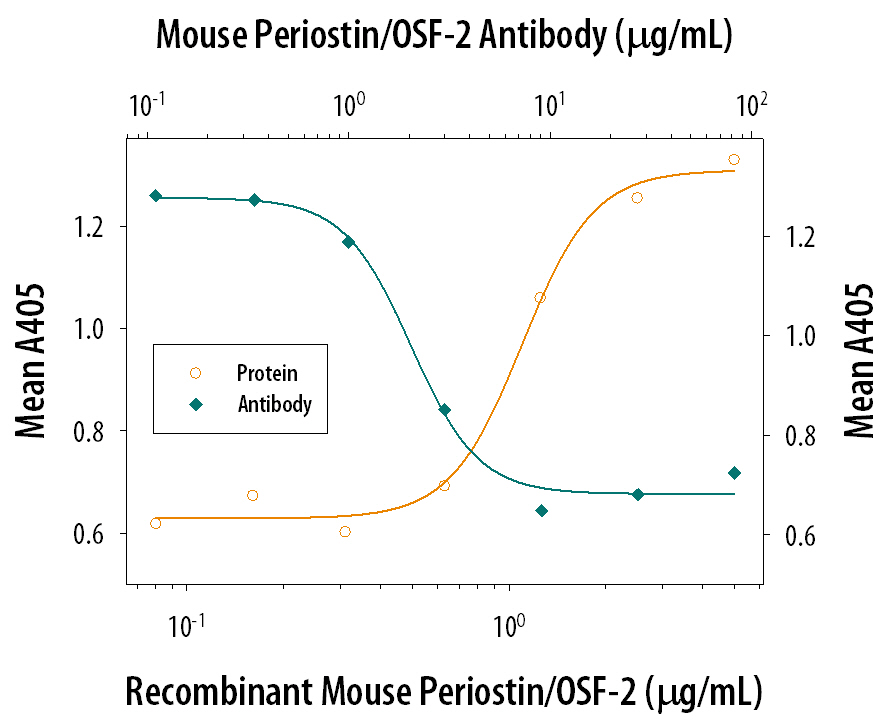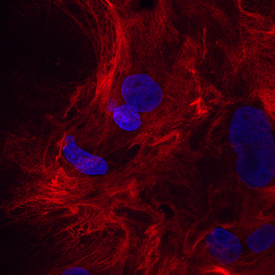Mouse Periostin/OSF-2 Isoform 2 Antibody Summary
Asn24-Gln811
Accession # Q62009
Applications
Please Note: Optimal dilutions should be determined by each laboratory for each application. General Protocols are available in the Technical Information section on our website.
Scientific Data
 View Larger
View Larger
Cell Adhesion Mediated by Periostin/OSF‑2 and Neutral-ization by Mouse Periostin/ OSF‑2 Antibody. Recombinant Mouse Periostin/OSF-2 (2955-F2), immobilized onto a microplate, supports the adhesion of the ATDC5 mouse chondrogenic cell line in a dose-dependent manner (orange line). Adhesion elicited by Recombinant Mouse Periostin/OSF-2 (5 µg/mL) is neutralized (green line) by increasing concentrations of Goat Anti-Mouse Periostin/ OSF-2 Isoform 2 Antigen Affinity-purified Polyclonal Antibody (Catalog # AF2955). The ND50 is typically 1-5 µg/mL.
 View Larger
View Larger
Periostin/OSF‑2 in Rat Mesenchymal Stem Cells. Periostin/OSF-2 was detected in immersion fixed rat mesenchymal stem cells differentiated to osteoblasts using Goat Anti-Mouse Periostin/OSF-2 Isoform 2 Antigen Affinity-purified Polyclonal Antibody (Catalog # AF2955) at 10 µg/mL for 3 hours at room temperature. Cells were stained using the NorthernLights™ 557-conjugated Anti-Goat IgG Secondary Antibody (red; NL001) and counterstained with DAPI (blue). Specific staining was localized to cytoplasm. View our protocol for Fluorescent ICC Staining of Cells on Coverslips.
Reconstitution Calculator
Preparation and Storage
- 12 months from date of receipt, -20 to -70 °C as supplied.
- 1 month, 2 to 8 °C under sterile conditions after reconstitution.
- 6 months, -20 to -70 °C under sterile conditions after reconstitution.
Background: Periostin/OSF-2
Mouse Periostin, also known as OSF-2 (osteoblast-specific factor 2) is a 170 kDa, secreted, homodimeric protein that belongs to the periostin family of the FAS1 superfamily of molecules (1‑4). It is a TGF-beta inducible molecule that serves as both an adhesion molecule and tumor suppressor (2, 5, 6, 7). It is synthesized as a 838 amino acid (aa) precursor that contains a 23 aa signal sequence and an 815 aa mature region (2, 8). It is unknown if the molecule has any significant glycosylation (2). Based on human OSF-2, the homodimer is not disulfide-linked (3). The molecule consists of two distinct regions. The N-terminus contains an 55 aa EMI domain, while the C-terminus contains four, 130 aa fasciculin type 1 (or FAS1) domains. The EMI domain is cysteine-rich and shows a highly basic alpha -helix (9). Each FAS1 repeat exhibits a novel 7-stranded beta -wedge with a multiple alpha -helix fold (1, 8). Multiple alternate splice forms are known to exist C-terminal (aa 672‑812) to the four-fold FAS1 repeats. These mature molecules are 760, 761, 787 and 788 aa in length and show block deletions of 54 aa, 27 aa and/or 28 aa (10). The significance of the alternate splice forms is not clear. They do, however, appear to be temporally regulated (6). OSF-2 is known to bind to alpha v beta 3 and alpha v beta 5 integrins (3). It is synthesized by smooth muscle cells, fibroblasts and osteoblasts (2, 5, 7). Mature mouse OSF-2 shares 98%, 92% and 91% aa identity with rat, canine and human OSF‑2, respectively.
- Clout, N.J. and D. Tisi (2003) Structure 11:197.
- Horiuchi, K. et al. (1999) J. Bone Miner. Res. 14:1239.
- Gillan, L. et al. (2002) Cancer Res. 62:5358.
- Litvin, J. et al. (2005) Anat. Rec. A Discov. Mol. Cell. Evol. Biol. 287A:1205.
- Lindner, V. et al. (2005) Arterioscler. Thromb. Vasc. Biol. 25:77.
- Kruzynska-Frejtag, A. et al. (2004) Dev. Dyn. 229:857.
- Yoshioka, N. et al. (2002) Exp. Cell Res. 279:91.
- Takeshita, S. et al. (1993) Biochem. J. 294:271.
- Callebaut, I. et al. (2003) Biochem. Biophys. Res. Commun. 300:619.
- Swiss-Prot Accession # Q62009.
Product Datasheets
Citations for Mouse Periostin/OSF-2 Isoform 2 Antibody
R&D Systems personnel manually curate a database that contains references using R&D Systems products. The data collected includes not only links to publications in PubMed, but also provides information about sample types, species, and experimental conditions.
17
Citations: Showing 1 - 10
Filter your results:
Filter by:
-
Fibroblasts facilitate lymphatic vessel formation in transplanted heart
Authors: Gong, H;Wang, T;Sun, X;Zhang, Y;Qiu, Y;Sun, W;Zhang, Y;Teng, P;Hu, Y;Hu, X;Ma, L;Xu, Q;Zhao, H;
Theranostics
Species: Murine polyomavirus strain A3, Viral
Sample Types: Cell Lysates, Tissue Homogenates, Whole Tissue
Applications: Immunohistochemistry, Western Blot -
Diabetes Induces Cardiac Fibroblast Activation, Promoting a Matrix-Preserving Nonmyofibroblast Phenotype, Without Stimulating Pericyte to Fibroblast Conversion
Authors: L Alex, I Tuleta, A Hanna, NG Frangogian
Journal of the American Heart Association, 2023-03-09;0(0):e027463.
Species: Transgenic Mouse
Sample Types: Whole Tissue
Applications: IHC -
Bone marrow and periosteal skeletal stem/progenitor cells make distinct contributions to bone maintenance and repair
Authors: EC Jeffery, TLA Mann, JA Pool, Z Zhao, SJ Morrison
Cell Stem Cell, 2022-10-21;29(11):1547-1561.e6.
Species: Mouse
Sample Types: Whole Tissue
Applications: IHC -
FGFR3 in Periosteal Cells Drives Cartilage-to-Bone Transformation in Bone Repair
Authors: A Julien, S Perrin, O Duchamp de, C Carvalho, M Bensidhoum, L Legeai-Mal, C Colnot
Stem Cell Reports, 2020-09-10;0(0):.
Species: Mouse
Sample Types: Whole Tissue
Applications: IHC -
Hox11 expressing regional skeletal stem cells are progenitors for osteoblasts, chondrocytes and adipocytes throughout life
Authors: KM Pineault, JY Song, KM Kozloff, D Lucas, DM Wellik
Nat Commun, 2019-07-18;10(1):3168.
Species: Mouse
Sample Types: Whole Tissue
Applications: IHC -
Short-term RANKL exposure initiates a neoplastic transcriptional program in the basal epithelium of the murine salivary gland
Authors: L Hai, MM Szwarc, DM Lonard, K Rajapakshe, D Perera, C Coarfa, M Ittmann, R Fernandez-, JP Lydon
Cytokine, 2019-06-18;123(0):154745.
Species: Human
Sample Types: Tissue Lysates, Whole Tissue
Applications: IHC, Western Blot -
New Noonan syndrome model mice with RIT1 mutation exhibit cardiac hypertrophy and susceptibility to ?-adrenergic stimulation-induced cardiac fibrosis
Authors: S Takahara, SI Inoue, S Miyagawa-T, K Matsuura, Y Nakashima, T Niihori, Y Matsubara, Y Saiki, Y Aoki
EBioMedicine, 2019-03-18;0(0):.
Species: Mouse
Sample Types: Tissue Homogenates, Whole Tissue
Applications: IHC, Western Blot -
Periostin deletion suppresses late-phase response in mouse experimental allergic conjunctivitis
Authors: Y Asada, M Okano, W Ishida, S Iwamoto, K Fukuda, T Hirakata, N Tada, A Fukushima, N Ebihara, A Kudo, A Matsuda
Allergol Int, 2018-11-09;0(0):.
Species: Mouse
Sample Types: Whole Tissue
Applications: IHC-P -
Macrophage-derived granulin drives resistance to immune checkpoint inhibition in metastatic pancreatic cancer
Authors: V Quaranta, C Rainer, SR Nielsen, ML Raymant, MS Ahmed, DD Engle, A Taylor, T Murray, F Campbell, DH Palmer, DA Tuveson, A Mielgo, MC Schmid
Cancer Res., 2018-05-22;0(0):.
Species: Mouse
Sample Types: Whole Cells
Applications: Neutralization -
Multicolor quantitative confocal imaging cytometry
Authors: DL Coutu, KD Kokkaliari, L Kunz, T Schroeder
Nat. Methods, 2017-11-13;15(1):39-46.
Species: Mouse
Sample Types: Whole Tissue
Applications: IHC -
Deletion of the Ste20-like kinase SLK in skeletal muscle results in a progressive myopathy and muscle weakness
Authors: BR Pryce, KN Al-Zahrani, S Dufresne, N Belkina, C Labr?che, G Patino-Lop, J Frenette, S Shaw, LA Sabourin
Skelet Muscle, 2017-02-02;7(1):3.
Species: Mouse
Sample Types: Tissue Homogenates
Applications: Western Blot -
Macrophage-secreted granulin supports pancreatic cancer metastasis by inducing liver fibrosis
Authors: SR Nielsen, V Quaranta, A Linford, P Emeagi, C Rainer, A Santos, L Ireland, T Sakai, K Sakai, YS Kim, D Engle, F Campbell, D Palmer, JH Ko, DA Tuveson, E Hirsch, A Mielgo, MC Schmid
Nat Cell Biol, 2016-04-18;0(0):.
Species: Mouse
Sample Types: Whole Cells
Applications: Neutralization -
A mouse model for dominant collagen VI disorders: heterozygous deletion of Col6a3 Exon 16.
Authors: Pan T, Zhang R, Arita M, Bogdanovich S, Adams S, Gara S, Wagener R, Khurana T, Birk D, Chu M
J Biol Chem, 2014-02-22;289(15):10293-307.
Species: Mouse
Sample Types: Whole Tissue
Applications: IHC -
Periostin links mechanical strain to inflammation in abdominal aortic aneurysm.
Authors: Yamashita, Osamu, Yoshimura, Koichi, Nagasawa, Ayako, Ueda, Koshiro, Morikage, Noriyasu, Ikeda, Yasuhiro, Hamano, Kimikazu
PLoS ONE, 2013-11-19;8(11):e79753.
Species: Rat
Sample Types: Whole Cells
Applications: Neutralization -
Pressure overload-induced cardiac remodeling and dysfunction in the absence of interleukin 6 in mice.
Authors: Lai, N Chin, Gao, Mei Hua, Tang, Eric, Tang, Ruoying, Guo, Tracy, Dalton, Nancy D, Deng, Aihua, Tang, Tong
Lab Invest, 2012-07-23;92(11):1518-26.
Species: Mouse
Sample Types: Tissue Homogenates
Applications: Western Blot -
Quantitative analysis of the secretome of TGF-beta signaling-deficient mammary fibroblasts.
Authors: Xu BJ, Yan W, Jovanovic B
Proteomics, 2010-07-01;10(13):2458-70.
Species: Mouse
Sample Types: Cell Lysates
Applications: Western Blot -
Periostin, a member of a novel family of vitamin K-dependent proteins, is expressed by mesenchymal stromal cells.
Authors: Coutu DL, Wu JH, Monette A, Rivard GE, Blostein MD, Galipeau J
J. Biol. Chem., 2008-04-30;283(26):17991-8001.
Species: Human, Mouse
Sample Types: Cell Lysates
Applications: Western Blot
FAQs
No product specific FAQs exist for this product, however you may
View all Antibody FAQsReviews for Mouse Periostin/OSF-2 Isoform 2 Antibody
Average Rating: 4.7 (Based on 6 Reviews)
Have you used Mouse Periostin/OSF-2 Isoform 2 Antibody?
Submit a review and receive an Amazon gift card.
$25/€18/£15/$25CAN/¥75 Yuan/¥2500 Yen for a review with an image
$10/€7/£6/$10 CAD/¥70 Yuan/¥1110 Yen for a review without an image
Filter by:
3 mice hearts extractions expressing periostin after MI. HSP60 used as loading marker.
primary rat cardiac fiboblasts. periostin in green and DAPI in blue
mouse heart post MI fixed in PFA stained to periostin in red, troponin I in green and DAPI in blue







